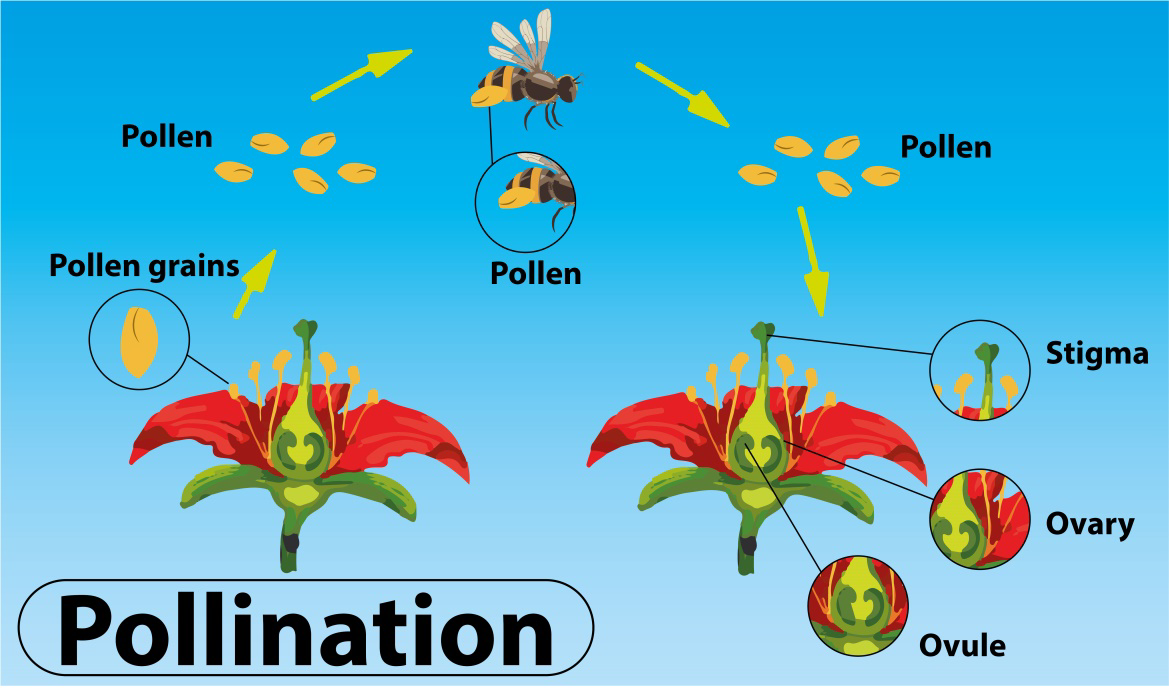Answer
428.7k+ views
Hint: Pollination is the process of transfer of the pollen grains from the anther to the stigma of a flower. It is of two types based on whether the transfer is among the same or different plants. Cross-pollination through an insect agent is the most common type of pollination observed in the ecosystem.
Complete answer:
Cross-pollination is also known as allogamy. It is the transfer of pollen grains from an anther of a flower to the stigma of another flower, borne on separate plants of the same species. It results in the combination or mixing-up of characters, thus, improving the quality or vigor of the species. Various agencies are helpful in cross-pollinating flowers and they are broadly classified into two types i.e biotic agencies and abiotic agencies. When biotic agents are involved in cross-pollination, the process is collectively called as zoophily. They are further divided into various groups. The most common among them is entomophily. It is the cross-pollination through an insect agent
Additional Information: -Pollination by insects occurs in plants with conspicuous and brightly colored flowers that bear nectar to attract the insects. The most prevalent insect forms are bees and butterflies.
-The abiotic agencies include wind and water. Pollination with the help of air or wind is called anemophily while hydrophily is the pollination taking place with the help of water.
-Pollination through birds like hummingbirds is known as ornithophily. When snails are the biotic agents in dispersing the pollens, then such types of pollination are referred to as malacophily. Anthropophily is the cross-pollination via humans. This is a type of artificial pollination wherein the pollination is unable to occur naturally and requires procedures and techniques by humans.
So, the correct answer is ‘Entomophily.’
Note: In the flowering plants, the gynoecium is the female reproductive organ. It is composed of a sticky stigma which acts as a receptacle for the landing of pollens. The pollen upon germination gives rise to a pollen tube, which follows the path along the tube of style that ends into the swollen base i.e the ovary. It bears the ovule bearing the female gamete. The male gamete then fuses with the female gamete giving rise to a unicellular diploid zygote.

Complete answer:
Cross-pollination is also known as allogamy. It is the transfer of pollen grains from an anther of a flower to the stigma of another flower, borne on separate plants of the same species. It results in the combination or mixing-up of characters, thus, improving the quality or vigor of the species. Various agencies are helpful in cross-pollinating flowers and they are broadly classified into two types i.e biotic agencies and abiotic agencies. When biotic agents are involved in cross-pollination, the process is collectively called as zoophily. They are further divided into various groups. The most common among them is entomophily. It is the cross-pollination through an insect agent
Additional Information: -Pollination by insects occurs in plants with conspicuous and brightly colored flowers that bear nectar to attract the insects. The most prevalent insect forms are bees and butterflies.
-The abiotic agencies include wind and water. Pollination with the help of air or wind is called anemophily while hydrophily is the pollination taking place with the help of water.
-Pollination through birds like hummingbirds is known as ornithophily. When snails are the biotic agents in dispersing the pollens, then such types of pollination are referred to as malacophily. Anthropophily is the cross-pollination via humans. This is a type of artificial pollination wherein the pollination is unable to occur naturally and requires procedures and techniques by humans.
So, the correct answer is ‘Entomophily.’
Note: In the flowering plants, the gynoecium is the female reproductive organ. It is composed of a sticky stigma which acts as a receptacle for the landing of pollens. The pollen upon germination gives rise to a pollen tube, which follows the path along the tube of style that ends into the swollen base i.e the ovary. It bears the ovule bearing the female gamete. The male gamete then fuses with the female gamete giving rise to a unicellular diploid zygote.

Recently Updated Pages
Mark and label the given geoinformation on the outline class 11 social science CBSE

When people say No pun intended what does that mea class 8 english CBSE

Name the states which share their boundary with Indias class 9 social science CBSE

Give an account of the Northern Plains of India class 9 social science CBSE

Change the following sentences into negative and interrogative class 10 english CBSE

Advantages and disadvantages of science

Trending doubts
Difference between Prokaryotic cell and Eukaryotic class 11 biology CBSE

Differentiate between homogeneous and heterogeneous class 12 chemistry CBSE

Fill the blanks with the suitable prepositions 1 The class 9 english CBSE

Which are the Top 10 Largest Countries of the World?

Give 10 examples for herbs , shrubs , climbers , creepers

10 examples of evaporation in daily life with explanations

Difference Between Plant Cell and Animal Cell

Write a letter to the principal requesting him to grant class 10 english CBSE

Change the following sentences into negative and interrogative class 10 english CBSE



